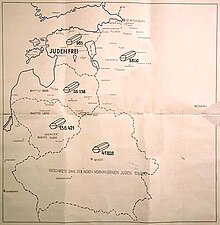Kaunas pogrom

The Kaunas pogrom was a massacre of Jews living in Kaunas, Lithuania, that took place on June 25–29, 1941 – the first days of the Operation Barbarossa and of Nazi occupation of Lithuania. The most infamous incident occurred at the garage of NKVD Kaunas section, a nationalized garage of Lietūkis, where several dozen Jewish men were publicly tortured and executed on June 27 in front of a crowd of cheering Lithuanian men, women and children. The incident was documented by a German soldier who photographed the event as a Lithuanian man nicknamed the "Death Dealer" beat each man to death with a metal bar. After June, systematic executions took place at various forts of the Kaunas Fortress, especially the Seventh and Ninth Fort.[1]
Background

The Lithuanian Activist Front (LAF), a national liberation organisation operating inside Soviet Lithuania, took control of the city[3] and much of the Lithuanian countryside on the evening of June 23, 1941. Nazi SS Brigadeführer Franz Walter Stahlecker arrived in Kaunas on the morning of June 25. He visited the headquarters of the Lithuanian Security Police and delivered a long anti-Semitic speech encouraging Lithuanians to solve the "Jewish problem".[4] According to Stahlecker's report of October 15, local Lithuanians were not enthusiastic about the pogrom and so he had to use Algirdas Klimaitis and his men.[4] Klimaitis controlled a paramilitary unit of roughly 600 men that was organized in Tilsit by SD and was not subordinated to the LAF.[4]
Massacre

Starting on June 25, Nazi-organized units attacked Jewish civilians in Slobodka (Vilijampolė), the Jewish suburb of Kaunas that hosted the world-famous Slabodka yeshiva. According to Rabbi Ephraim Oshry, there were Germans present on the bridge to Slobodka, but it was the Lithuanian volunteers who killed the Jews. The rabbi of Slobodka, Rav Zalman Osovsky, was tied hand and foot to a chair, "then his head was laid upon an open volume of gemora (volume of the Talmud) and [they] sawed his head off", after which they murdered his wife and son. His head was placed in a window of the residence, bearing a sign: "This is what we'll do to all the Jews."[5]
As of June 28, 1941, according to Stahlecker, 3,800 people had been killed in Kaunas and a further 1,200 in other towns in the immediate region.[3] Some believe Stahlecker exaggerated his murder tally.[6][7]
Controversy

There is controversy over who is primarily responsible for initiating the massacres: local Lithuanians or Nazi officials.
Some Lithuanians cite Franz Walter Stahlecker's report of October 15 to Heinrich Himmler. Stahlecker wrote that he had succeeded in covering up actions of the Vorkommando (German vanguard unit) and made it look like an initiative of the local population.[4]
Other authors claim that massacres began even before Germans arrived.[8] They point out that executions took place in the countryside and not just in the city of Kaunas.[9]
See also
References
- ^ Arvydas Anušauskas; et al., eds. (2005). Lietuva, 1940–1990 (in Lithuanian). Vilnius: Lietuvos gyventojų genocido ir rezistencijos tyrimo centras. p. 203. ISBN 9986-757-65-7.
- ^ "The Death Dealer of Kovno - Beachcombing's Bizarre History Blog". 31 March 2011.
- ^ a b MacQueen, Michael (1998). "Nazi Policy towards the Jews in the Reichskommissariat Ostland, June–December 1941: From White Terror to Holocaust in Lithuania". In Gitelman, Zvi (ed.). Bitter Legacy: Confronting the Holocaust in the USSR. Indiana University Press. p. 97. ISBN 0-253-33359-8.
- ^ a b c d Bubnys, Arūnas (2003). "Lietuvių saugumo policija ir holokaustas (1941–1944)". Genocidas ir rezistencija (in Lithuanian). 13. ISSN 1392-3463. English translation of excerpts from Stahlecker's report available here: "The Einsatzgruppen: Report by Einsatzgruppe A in the Baltic Countries (October 15, 1941)". Jewish Virtual Library. American-Israeli Cooperative Enterprise. Retrieved 2015-03-29.
- ^ Oshry, Ephraim (1995). Annihilation of Lithuanian Jewry. New York: Judaica Press, Inc. p. 3. ISBN 1-880582-18-X.
- ^ Budreckis, Algirdas M. (1968). The Lithuanian National Revolt of 1941. Boston: Lithuanian Encyclopedia Press. pp. 62–63. OCLC 47283.
Again for some unknown reason, Stahlecker exaggerates his statistics. The account by L. Shauss to the Soviet Extraordinary State Commission stated that in "the first pogrom on June 25–26, in the Kaunas suburb of Slobodka (Vilijampolė), 600 Jews were killed on Arbarski, Paverski, Vilyuski, Irogalski streets."
- ^ Sužiedėlis, Saulius (Winter 2001). "The Burden of 1941". Lituanus. 4 (47). ISSN 0024-5089.
On the other hand, notwithstanding a number of such incidents, the available evidence does not support the image of huge mobs of locals hunting down Jews by the thousands even before the arrival of the Germans as some have claimed.
- ^ Greenbaum, Masha (1995). The Jews of Lithuania: A History of a Remarkable Community 1316–1945. Gefen Publishing House. p. 307. ISBN 9789652291325.
- ^ "'Lietūkio' garažo tragedija". Lzinios.lt. Retrieved 22 June 2007.
